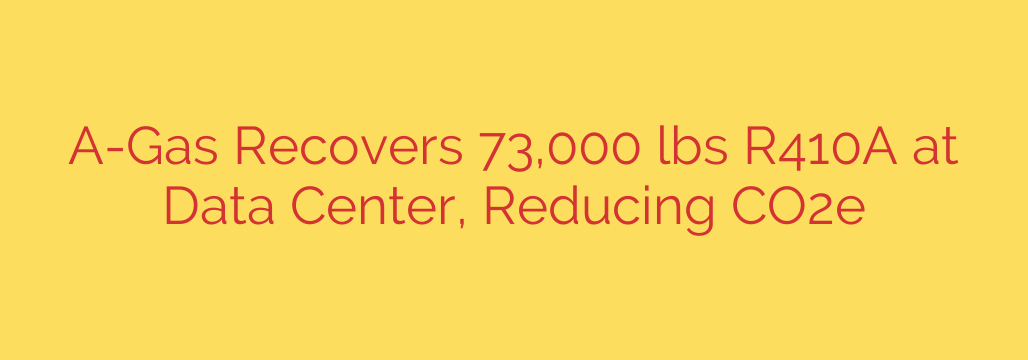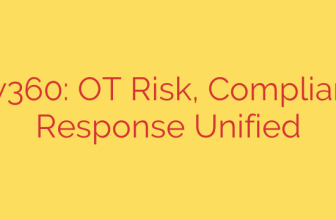
Reducing the Carbon Footprint of Data Centers: The Critical Role of Refrigerant Recovery
Data centers are the backbone of our digital world, but their immense power consumption and cooling needs come with a significant environmental cost. While much of the focus on “green” data centers is on energy efficiency, a critical and often overlooked component is the management of refrigerants—powerful greenhouse gases used in essential cooling systems.
A recent large-scale project highlights the massive environmental benefits of responsible refrigerant management. In a complex operation at a major data center, a leading refrigerant lifecycle management company successfully recovered over 73,000 pounds of R-410A refrigerant from cooling units that were being decommissioned. This single act of responsible recovery is a powerful case study in corporate environmental stewardship.
The Hidden Climate Impact of Cooling Systems
Modern data centers rely on powerful HVAC and chiller systems to maintain optimal operating temperatures for servers and other critical hardware. Many of these systems use hydrofluorocarbon (HFC) refrigerants like R-410A.
While effective for cooling, R-410A has a high Global Warming Potential (GWP). This means that if it escapes into the atmosphere, it traps significantly more heat than carbon dioxide. Venting or leaking this gas has a direct and damaging impact on the climate.
The environmental impact of the 73,000 pounds of recovered R-410A is staggering. By safely capturing this refrigerant instead of allowing it to be released, the project prevented the emission of over 76,000 metric tons of CO2 equivalent. This is comparable to taking more than 16,500 gasoline-powered cars off the road for an entire year.
Beyond Recovery: The Power of the Circular Economy
The story doesn’t end with simply capturing the gas. The recovered refrigerant isn’t waste; it’s a valuable resource. Through a sophisticated process known as reclamation, the used R-410A is purified, tested, and restored to meet the strict quality standards of new, virgin refrigerant.
This reclaimed product can then be reintroduced to the market, creating a sustainable, circular economy. The key benefits of this approach are threefold:
- Reduces Harmful Emissions: It directly prevents potent greenhouse gases from entering the atmosphere during system servicing or decommissioning.
- Conserves Resources: It reduces the need to manufacture new refrigerants, a process that is both energy-intensive and resource-dependent.
- Ensures Regulatory Compliance: As environmental regulations tighten, proper refrigerant management helps companies avoid significant fines and meet sustainability targets.
This process transforms a potential liability into a tangible asset, demonstrating that environmental responsibility and smart business practices can go hand-in-hand.
Actionable Steps for Sustainable Refrigerant Management
For facility managers and data center operators, this example offers a clear roadmap for reducing their own carbon footprint. Here are essential steps to take:
- Conduct a Full Refrigerant Audit: Understand the types and quantities of refrigerants used across your facility. A detailed inventory is the first step toward effective management.
- Develop a Lifecycle Management Plan: Don’t wait until a system is being decommissioned. Plan ahead for refrigerant recovery, reclamation, and eventual disposal for all your HVAC assets.
- Partner with Certified Professionals: Always use EPA-certified technicians and reputable recovery companies for any work involving refrigerants. They have the specialized equipment and expertise to handle these materials safely and in compliance with all regulations.
- Prioritize Leak Detection and Repair: The most common source of refrigerant emissions is slow leaks. Implementing a proactive maintenance and leak detection program can prevent significant environmental damage and improve system efficiency.
- Consider Low-GWP Alternatives: When upgrading or installing new cooling systems, explore modern refrigerants with a lower Global Warming Potential to future-proof your facility and further minimize its climate impact.
As the demand for data processing continues to grow, the industry’s responsibility to operate sustainably will only become more critical. While optimizing for power usage efficiency (PUE) is important, true environmental leadership requires a holistic approach. By embracing responsible refrigerant recovery and reclamation, data centers can make one of the most significant and immediate positive impacts on their carbon footprint.
Source: https://datacenternews.asia/story/a-gas-recovers-73-000-lbs-r410a-at-data-centre-cutting-co2e








